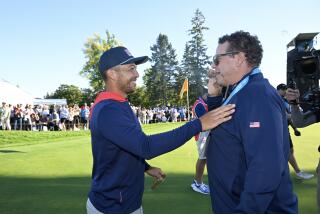America 3 Working Hard to Get Up to Speed : America’s Cup: Gary Jobson leads group in game of catch-up with other syndicates.
- Share via
SAN DIEGO — One syndicate assembling two America’s Cup crews was tough, but compared to what lies ahead for Gary Jobson, it was a virtual cakewalk.
“My job is a little like the general manager of a football team, recruiting people, getting them all here,” co-skipper Jobson said at a press conference Monday morning at the San Diego Yacht Club, where the America3 Foundation introduced its 38 crew members.
“I’m thriving on it,” he continued, “but I will say, the excitement of being involved has given way to the reality of it. This is going to be a hard sailboat race to win, really hard.”
Not that this revelation comes as a great surprise.
This is Jobson’s fourth America’s Cup campaign--two with Ted Turner, one with the late Tom Blackaller. This project, composed of 140 people, is enormous.
“This is much bigger,” Jobson said. “Between the sailing team, the coaches, trainers, public relations, physical training, the sailors themselves and the alternates, it’s 54 people. Just the staffing is such a big operation.”
Jobson, 40, said he looks over the harbor, where the New Zealand and Italian syndicates operate and realizes the catch-up work to be done.
“The Italians, they’re really organized and have a great program with great people,” Jobson said. “They’ve been here 1 1/2 years longer then we have. And Michael Fay’s syndicate has been in operation five years. They’ve really been at it so much longer than we have.”
Consider that as late as Jan. 12, America3 began holding two-week tryout sessions for 100 potential team members, whittled down from the 500 applicants.
“We’ve gone through quite a selection process to come up with this crew,” said Bill Koch, president and skipper of the syndicate. “Our main criteria has been attitude, teamwork and ability, and I think we have the best in the country in those areas.”
Said Jobson: “We didn’t just want to take 16 of our best friends and go sailing. We wanted to get the best.”
Having two teams, which must eventually merge into one, has advantages and disadvantages, according to Jobson.
“The whole premise was to design a program that created all the in-house competition we could. That’s the advantage,” he said. “The disadvantage is that it’s very hard to develop two first-string teams with two first-string sets of sails and boats. If you just have one, it’s much easier to develop 16 people than 32 people.”
The crew is training on the French-built USA2 until a boat built by Hercules, an aerospace manufacturing company in Salt Lake City, arrives in San Diego, possibly on Friday. Target delivery dates for two additional boats are July 1 and Dec. 1.
Design team manager Vincent Moeyersoms said 35 people are working on research projects in conjunction with boat design.
“We’re moving ahead quickly,” Moeyersoms said. “Time pressures are horrendous. We don’t have time to do all the testing we’d like to, but we’re doing a reasonable job. We feel we’ll be able to come up with a few surprises and a few breakthroughs in the next few months.”
Moeyersoms said America3 went with Hercules for the newest boat, dubbed USA9, because of its technological expertise.
“We felt the boats built in traditional boatyard technology have been maxed to a certain level,” he said. “We really had to go to the next step, to aeronautical expertise, to get the maximum performance out of the boat.”
Construction on the last boat--each takes six months and has a $3-million price tag--won’t begin until Jobson and crew have a chance to meet with the designers.
“Designers create the boats, but sailors take it and make it better,” Jobson said. “The idea starts with designers but they take our feedback about how the boat is performing.”
By May 1, America3 hopes to be situated in its Bay City compound, now under construction. It was difficult to find a site, Jobson said, because of the vast needs.
“It has to have a pen for two boats, good security so no one can dive and see the keel, a boat shed so you can pull the boats out and work on them, a sail loft to change the sails, a gymnasium, office space, machine shop, showers and locker rooms and VIP areas for entertainment.”
With so much work ahead, Jobson knows that defending champion Dennis Conner is still the man to catch.
“We have to beat Dennis,” he said. “He’s the champ. He’s the favorite. He likes to play the underdog, but the foreigners look at him as the favorite . . . and so do we.”


